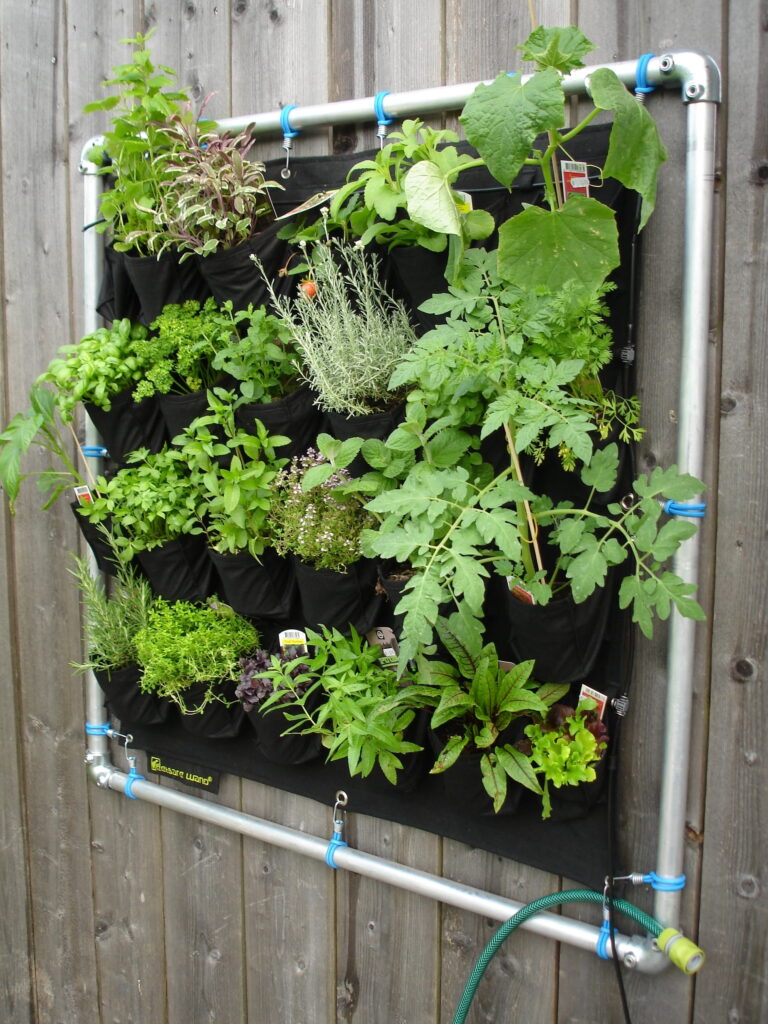Over the last few years, vertical planters have gained increasing popularity for both indoor and outdoor spaces. With outdoor spaces becoming more and more limited, gardeners all over the world are looking for new ways to make the most of their available area. That’s where outdoor vertical garden comes in – a great solution that’s catching on fast!
Let’s dig deeper into the transformative power of outdoor vertical gardening, exploring the origins, less-known techniques, benefits, and practical tips for creating stunning vertical gardens that defy conventional limitations.
Evolution of Vertical Gardening
Vertical gardening has been practiced for centuries and its roots can be traced back to the Hanging Gardens of Babylon. However, it wasn’t until the modern era that vertical gardening truly began to flourish as a popular gardening practice. In the 1980’s French botanist, Patrick Blanc popularized and modernized the vertical garden concept (Source).

The renewed interest in vertical gardening can be attributed to several factors, including urbanization, decreasing green spaces, and the growing desire for sustainable living. Beyond the practical advantages, vertical gardening fosters a deeper connection with nature, blurring the boundaries between indoor and outdoor spaces. They provide crucial sanctuaries for beneficial creatures and havens for contemplation in an increasingly hectic world. So, let’s reveal key techniques and structures of successful outdoor vertical gardening.
Techniques and Structures
Outdoor vertical garden ideas have no boundaries, whether you are planting veggies, flowers, herbs, or fruits. Add greenery and bring life to your outdoor spaces by creating beautiful outdoor vertical gardens using containers, trellises, or other supporting materials. The key here is the selection of suitable structures and techniques. So, let’s explore some incredibly effective vertical gardening techniques that can inspire you to create your own stunning vertical garden.

Living Walls: Living walls, also known as green walls or vertical gardens, are vertical structures covered in veggies. These structures can be freestanding or attached to existing walls and are typically comprised of modular panels filled with soil or growing medium. Living walls offer a stunning visual impact and provide numerous environmental benefits, including improved air quality, insulation, and biodiversity. On top of that, living walls require less soil as opposed to raised garden bed soil or in-ground gardening.
Vertical Planters: Vertical planters are another popular option for vertical gardening in outdoor spaces. These containers are designed to be mounted on walls or fences and come in various shapes and sizes. Vertical planters are ideal for growing herbs, flowers, and small vegetables, and fruits can be arranged in creative patterns to add visual interest to any outdoor area. One popular method for vertical gardening involves growing strawberries in vertical planters.

Trellises and Arbors: Trellises and arbors are perhaps the most basic form of vertical gardening structures. These simple frameworks provide support for climbing plants such as vines, peas, and cucumbers, allowing them to grow vertically and maximize space. Trellises come in various materials, including wood, metal, and PVC, and can be customizable to fit the dimensions of any outdoor space.
Benefits of Vertical Gardening
The benefits of vertical gardening extend far beyond aesthetic appeal. By utilizing vertical space, gardeners can maximize their growing area, increase biodiversity, and create microclimates that support a wide range of plant species. Vertical gardens also offer numerous environmental benefits, including improved air quality, reduced energy consumption, and stormwater management.
Additionally, vertical gardening can enhance the health and well-being of both humans and wildlife. Vertical gardens provide habitat for pollinators, birds, and beneficial insects, helping to restore biodiversity in urban environments. Furthermore, spending time in green spaces has been shown to reduce stress, improve mood, and promote overall well-being, making vertical gardens an invaluable addition to any outdoor area.
And above all, outdoor vertical gardening can be more environmentally friendly than traditional gardening methods. It often requires less water, fertilizer, and pesticides due to the controlled environment and efficient use of resources.
Practical Tips for Creating a Vertical Garden

Creating a vertical garden in an outdoor space may seem daunting. Yet, anyone can achieve stunning results with the right knowledge and planning. Here are some practical tips to help you get started:
- Assess Your Space: Before embarking on your vertical gardening journey, take the time to assess your outdoor space. Identify potential vertical surfaces for gardening. Consider factors such as sunlight exposure, wind exposure, and access to water when selecting a location for your outdoor vertical garden.
- Choose the Right Plants: Selecting the right plants is crucial for the success of your vertical garden. Choose plants that are well-suited to your climate, sunlight exposure, and soil conditions, and consider the mature size of the plants when planning your vertical garden layout.
- Prepare Your Vertical Structure: Depending on the vertical gardening structure you choose, you may need to prepare the surface by installing support brackets, anchors, or irrigation systems. Follow the manufacturer’s instructions carefully to ensure proper installation and stability.
- Plant Carefully: When planting, be mindful of spacing and plant placement to ensure adequate room for growth and airflow. Water your vertical garden regularly, especially during hot weather or periods of drought, and monitor for pests and diseases.
- Maintain Your Vertical Garden: Like any garden, vertical gardens require regular maintenance to keep them healthy and vibrant. Prune and trim plants as needed, remove weeds and debris and fertilize regularly to promote growth and flowering.
To Sum Things up
Vertical gardening has revolutionized the way we think about outdoor spaces. It offers a sustainable and aesthetically pleasing solution for maximizing space and reconnecting with nature. Whether you’re a seasoned gardener or a novice enthusiast, outdoor vertical garden provides endless opportunities for creativity, innovation, and exploration. So why wait? Embrace the vertical and elevate your outdoor space to new heights with the art and science of vertical gardening.
